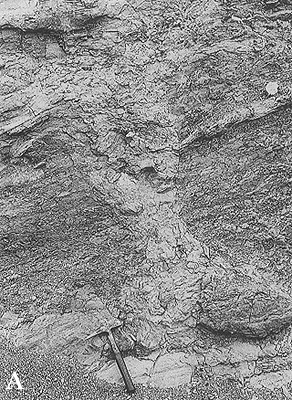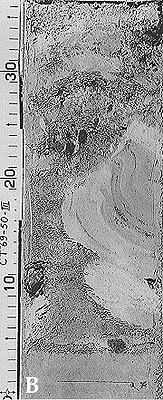

Details of paleoslides: outcrop vs. core
Plate 137


Details of paleoslides: outcrop vs. core
Plate 137
Plate 137 A shows another detail of plate 132, this time from its uppermost part. A kind of crevasse was opened in the slide body (by the pulling apart of two blocks?), and fluid or plastic mud filled it. The sea bed was not much above. The crevasse stopped against a harder layer (bottom of picture).
The disturbed sediment shown in plate 137 B is fine-grained and was cored in an underwater slide body similar to that seen in plate 130. Small pebbles are embedded in it, which suggests mixing of different materials.
Apart from deformations induced by the coring process itself, no observations can be made on the style and geometry of disturbed structures. The lighter patch to the right, for example, could represent either a mud chunk or the end of a contorted bed. One can only say is that bedding is disturbed or chaotic. An important indication comes, however, from the pebbles; unless they were dropped by melting ice or other floating objects, their presence in mud can be explained by mixing of marine sediment with beach or river derived gravel caused by a mass transport. A slide in a coastal zone could have evolved into a debris flow by incorporating water and disaggregating. In conclusion, the cored sediment may represent the indirect record of a slide.
Some decades ago, before the role of gravity in sedimentation was fully appreciated, most debris flow deposits were interpreted as glacial or periglacial sediments. A muddy sediment containing scattered clasts was invariably attributed to glacial transport and called a till, or a tillite if lithified. Subsequently, the terms diamicton (diamictite ) and pebbly mud (stone) (when the clasts are rounded) were introduced for purely descriptive purposes. They do not imply any particular mechanism of origin, even though pebbly mudstones are commonly regarded as products of mass flows.
| Photo: B Institute for Marine Geology C.N.R. 1970. |